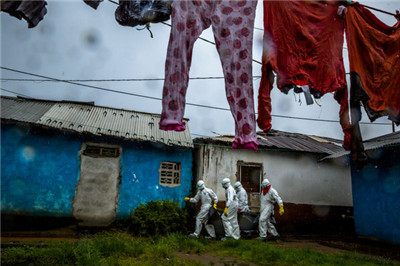(单词翻译:单击)
Yet another set of ominous projections about the Ebola epidemic in West Africa was released Tuesday, in a report from the Centers for Disease Control and Prevention that gave worst- and best-case estimates for Liberia and Sierra Leone based on computer modeling.
本周二,美国疾病控制与预防中心(Centers for Disease Control and Prevention,简称CDC)发布了一份报告,对西非的埃博拉疫情做出了不乐观的预测。该报告使用计算机建模,针对利比里亚和塞拉利昂的疫情,进行了最坏和最好情况的估计。

In the worst-case scenario, the two countries could have a total of 21,000 cases of Ebola by Sept. 30 and 1.4 million cases by Jan. 20 if the disease keeps spreading without effective methods to contain it. These figures take into account the fact that many cases go undetected, and estimate that there are actually 2.5 times as many as reported.
在最坏的情况下,到9月30日,这两个国家可能共有2.1万宗埃博拉病例,如果病情不断蔓延,缺乏有效的方法来遏制它,那么到明年1月20日,会增至140万宗。CDC考虑到很多病例都没有被发现,估计实际病例可能是统计数据的2.5倍,据此得出了以上预测。
In the best-case model, the epidemic in both countries would be “almost ended” by Jan. 20, the report said. Success would require conducting safe funerals at which no one touches the bodies, and treating 70 percent of patients in settings that reduce the risk of transmission. The report said the proportion of patients now in such settings was about 18 percent in Liberia and 40 percent in Sierra Leone.
报告称,在最好的情况下,到1月20日,这两个国家的疫情“几乎会结束”。要实现这一点,就需要安全地开展丧葬,在这个过程中不让任何人触及尸体,并且需要在可以降低传染风险的环境中,治疗70%的患者。该报告表示,目前处在这种环境中的患者,在利比里亚只有约为18%,塞拉利昂约为40%。
The caseload projections are based on data from August, but Dr. Thomas R. Frieden, the C.D.C. director, said the situation appeared to have improved since then because more aid had begun to reach the region.
该报告根据8月的数据,做出了疫情猖獗的预测,但CDC主任托马斯·R·弗雷登(Thomas R. Frieden)博士表示,8月之后,随着更多的援助逐渐抵达了该地区,疫情似乎有所改善。
“My gut feeling is, the actions we’re taking now are going to make that worst-case scenario not come to pass,” Dr. Frieden said in a telephone interview. “But it’s important to understand that it could happen.”
“我的直觉是,鉴于我们目前采取的行动,最坏的情况不会应验,”弗里登博士在接受电话采访时说。“但重要的是要明白,那是有可能发生的。”
Outside experts said the modeling figures were in line with estimates by others in the field.
外界专家称,CDC的建模数目与该领域其他人的预测相吻合。
“It’s a nice job,” said Ira Longini, a professor of biostatistics at the University of Florida who has also done computer modeling of the epidemic. “It summarizes the extent of the problem and what has to happen to deal with it.”
“这份报告很不错,”佛罗里达大学生物统计学教授艾拉·朗吉尼(Ira Longini)说,他也对这次疫情进行了计算机建模。“它总结了问题的严重程度,以及要应对它,必须开展哪些工作。”
Bryan Lewis, an epidemiologist at the Virginia Bioinformatics Institute at Virginia Tech, agreed that the estimates were reasonable, perhaps even a bit low compared with those generated by other models. He said that if some of the latest data from the World Health Organization is plugged into the C.D.C. model, “the very large numbers of estimated cases are, unfortunately, even larger.”
布莱恩·刘易斯(Bryan Lewis)是一名流行病学家,供职于弗吉尼亚理工大学(Virginia Tech)弗吉尼亚生物信息学研究所(Virginia Bioinformatics Institute),他认为这些估计是合理的,相对于其他模型得出的估计数目而言,甚至有点偏低。他说,如果CDC的模型使用世界卫生组织(World Health Organization,简称WHO)的一些最新数据,那么“很不幸,这些已经非常大的病例估计数目,甚至就会变得更大”。
The current official case count is 5,843, including 2,803 deaths, according to the W.H.O.
WHO目前的官方数据显示,病例数目已达5843例,其中包括已经死亡的2803例。
The C.D.C. estimates omit Guinea, which has been hit hard, because the epidemic struck in waves that could not be modeled.
CDC没有对几内亚的猖獗疫情进行估计,因为在该国,埃博拉是一波一波来袭的,研究者无法对此建模。
The W.H.O. published its own revised estimates of the outbreak on Monday, predicting more than 20,000 cases by Nov. 2 if control does not improve. That figure is more conservative than the one from the C.D.C., but the W.H.O. report also noted that many cases were unreported and said that without effective help, the three most affected countries would soon be reporting thousands of cases and deaths per week. It said its projections were similar to those from the C.D.C.
本周一,WHO修订了自己的估计数字,称如果疫情控制状况没有得到改善,那么到11月2日,病例数目将超过2万例。这个数字比CDC的预计保守,但WHO的报告还指出,很多病例都未经报告,如果缺乏行之有效的帮助,疫情最严重的三个国家很快就会报告每周数千人的死亡数目。WHO说,自己的预测与CDC的很相似。
The W.H.O. report also raised, for the first time, the possibility that the disease would not be stopped but could become endemic in West Africa, meaning that it could become a constant presence there.
WHO的报告还首次指出,这种疾病不会消失,而是可能会成为西非的地方病,这意味着,埃博拉可能在那里成为一种常见病。
President Obama’s promise last week to send 3,000 military personnel to Liberia and to build 17 hospitals there, each with 100 beds, was part of the solution, Dr. Frieden said. But it was not clear when those hospitals would be ready, or who would staff them.
上周,奥巴马总统承诺,将派遣3000名军事人员到利比里亚,搭建17家医院,每家提供100张床位;弗雷登博士说,这是整个解决方案的一部分。不过目前还不清楚,这些医院将在何时准备好,以及由谁来提供医疗服务。
Dr. Frieden said the Defense Department had already delivered parts of a 25-bed unit that would soon be set up to treat health workers who become infected, a safety measure he said was important to help encourage health professionals to volunteer. He said that more aid groups were also arriving in the region to set up treatment centers, and that a “surge” of help would “break the back of the epidemic.”
弗雷登博士说,国防部已经提供了一些材料,用来搭建一个25个床位的病房,以便治疗那些感染了埃博拉的医疗人员,搭建工作将很快完成。他说,这是一个很重要的安全措施,有益于鼓励医务人员担当志愿者。他说,还有更多援助团正在抵达该地区,以搭建治疗中心,而且“一大波”援助将会“很好控制住埃博拉疫情”。
Dr. Jack Chow, a professor of global health at Carnegie Mellon University and a former W.H.O. official, said, “The surge only becomes realized when those beds are up and operating and the workers are delivering care.”
卡内基梅隆大学(Carnegie Mellon University)全球卫生教授周启康博士(Dr. Jack Chow)曾是WHO官员,他说,“只有当这些床位都建好,投入使用,而且有人提供医疗服务时,这一大波援助才能变成现实。”
He added, “If even the medium case comes to pass, with, say, 700,000 cases by January, the epidemic will quickly overwhelm the capabilities that the U.S. plans to send.”
他还说,“就算只是出现了预测的中间情况,比如1月时,病例数目达到70万例,那么疫情也将迅速压垮美国计划提供的援助。”
The W.H.O. reported that a new center had just opened in Monrovia, the Liberian capital, with 120 beds for treatment and 30 for triage. Patients were already lined up at the door.
WHO的报告称,一家新的治疗中心刚刚在利比里亚首都蒙罗维亚开业,它拥有120张治疗床位,还有30张床位用于分诊。患者已经在门口一字排开。
The report from the C.D.C. acknowledged that case counts were rising faster than hospital beds could be provided. It said that in the meantime, different types of treatment would be used, based in homes or community centers, with relatives and others being given protective gear to help prevent the disease from spreading.
CDC报告承认,和可以提供的床位数目相比,病例数目的增长速度更快。该组织表示,在此期间,可以采用不同类型的治疗方式,让患者在家中或社区中心里,接受亲戚和其他人的护理。护理者将获得保护设备,以防止疾病蔓延。
The United States government is also sending 400,000 kits containing gloves and disinfectant to Liberia to help families take care of patients at home.
美国政府还将运送40万份手套和消毒剂到利比里亚,以帮助患者的家人在家中护理他们。
At least one aid group in Liberia is already shifting its focus to teaching people about home care and providing materials to help because there are not enough hospital beds for the sick. Ken Isaacs, a vice president of the group, Samaritan’s Purse, said, “I believe inevitably this is going to move into people’s houses, and the notion of home-based care has to play a more prominent role.”
在利比里亚,由于没有足够的床位供患者住院,至少有一个援助组织已经转移工作重心,开始侧重于教导人们如何开展家庭护理,并提供相应的物资。该组织名为撒玛利亚救援会(Samaritan's Purse),其副主席肯·艾萨克斯(Ken Isaacs)说,“我认为护理工作将在家庭中开展,这一点不可避免,而家庭护理这个概念可以发挥更加突出的作用。”


